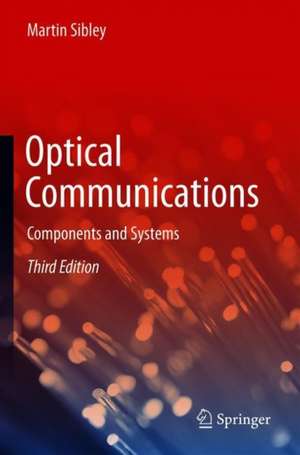Optical Communications: Components and Systems
Autor Martin Sibleyen Limba Engleză Paperback – 20 mar 2020
Updated throughout, major changes for this third edition include:
- coverage of advanced semiconductor laser diode structures (VCSELs and DFBs)
- an extended section on fibre amplifiers and lasers
- updated discussion of avalanche photodiode structures
- expanded coverage of transimpedance and optical preamplifiers
- new sections on free-space optical links, VLC, ethernet links, coherent detection and terabit systems
Enhanced with worked examples and end-of-chapter problem sets, the book is aimed at advanced undergraduate and graduate students in electronic engineering, optical science and applied physics, and is ideally suited for adoption as a course text.
Preț: 394.38 lei
Preț vechi: 486.89 lei
-19% Nou
Puncte Express: 592
Preț estimativ în valută:
75.50€ • 77.65$ • 62.63£
75.50€ • 77.65$ • 62.63£
Carte tipărită la comandă
Livrare economică 15-21 februarie
Preluare comenzi: 021 569.72.76
Specificații
ISBN-13: 9783030343583
ISBN-10: 3030343588
Pagini: 250
Ilustrații: XVII, 250 p. 98 illus.
Dimensiuni: 155 x 235 mm
Greutate: 0.38 kg
Ediția:3rd ed. 2020
Editura: Springer International Publishing
Colecția Springer
Locul publicării:Cham, Switzerland
ISBN-10: 3030343588
Pagini: 250
Ilustrații: XVII, 250 p. 98 illus.
Dimensiuni: 155 x 235 mm
Greutate: 0.38 kg
Ediția:3rd ed. 2020
Editura: Springer International Publishing
Colecția Springer
Locul publicării:Cham, Switzerland
Cuprins
Notă biografică
Dr Martin J.N. Sibley studied at the University of Huddersfield (then the Polytechnic of Huddersfield), UK, obtaining a BSc (Hons) in Electrical Engineering in 1981. He stayed on to do a PhD, conferred in 1984, researching preamplifiers for optical receivers. This work was sponsored by British Telecom Research Laboratories (BTRL) and resulted in the first preamplifier to be fabricated in IC form. A BTRL Research Fellowship followed, examining the practical design of a Digital Pulse Position Modulation (DPPM) coder and decoder. Theoretical predictions showed that DPPM could out-perform Pulse Code Modulation (PCM) and practical results obtained using the DPPM coder and decoder confirmed the predictions. He continues to research this area today.
In 1986 Martin joined the academic staff at the University of Huddersfield. His main research area is optical communications, in particular the practical implementation of Visible Light Communication (VLC) using high power LEDs, and coding schemes for highly dispersive optical links such as plastic optical fibre. He is also involved in research work concerned with the open-area detection of concealed weapons. He has acted as consultant to several blue-chip companies.
Martin has published over 80 conference and proceedings papers as well as four textbooks in the fields of electromagnetism, optical communications and telecommunications. He is a Member of the IET and a Fellow of the Higher Education Academy.
Martin has published over 80 conference and proceedings papers as well as four textbooks in the fields of electromagnetism, optical communications and telecommunications. He is a Member of the IET and a Fellow of the Higher Education Academy.
Textul de pe ultima copertă
The long-awaited third edition of this classic textbook provides a genuinely accessible introduction to the principles and technology of optical communication systems. It takes the reader from the fundamentals of light propagation in optical fibre, through materials and fabrication methods, light sources and modulation, to photodiodes and receiver design, and concludes with a chapter looking at system level integration.
Updated throughout, major changes for this third edition include:
- coverage of advanced semiconductor laser diode structures (VCSELs and DFBs)
- an extended section on fibre amplifiers and lasers
- updated discussion of avalanche photodiode structures
- expanded coverage of transimpedance and optical preamplifiers
- new sections on free-space optical links, VLC, ethernet links, coherent detection and terabit systems
Enhanced with worked examplesand end-of-chapter problem sets, the book is aimed at advanced undergraduate and graduate students in electronic engineering, optical science and applied physics, and is ideally suited for adoption as a course text.
Caracteristici
A readable introduction, from the principles of light propagation in fibre through to system level integration Describes the state of the art in free-space optical links, visible light communication and terabit systems Supported throughout with worked examples and end-of-chapter problem sets to enhance student comprehension
